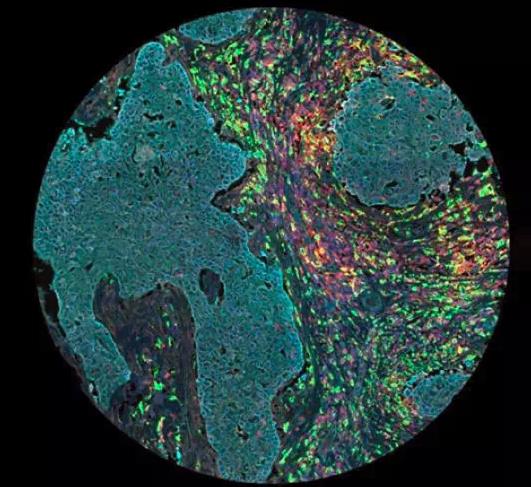Ansel Lim, Fourth-year NUS YLL School of Medicine student, puts aggressive breast cancer under the microscope.
Ansel Lim, Fourth-year NUS YLL School of Medicine student, puts aggressive breast cancer under the microscope.
Macrophages are "big eaters", large friendly white blood cells in the human body that seek out and wolf down foreign invaders such as bacteria and viruses.
But in patients with an aggressive disease known as triple negative breast cancer, a type of macrophage called the M2 macrophage has gone rogue and joined the ranks of the enemy, helping cancer cells to spread.
An image (below) of these treacherous red and green macrophages swimming among cancer cells bagged "overall winner" at the Breast Cancer Research Image competition this year (2017). The competition was open to those affiliated with a research institution or hospital.

"A tumour is never so naked and exposed as when it is under the microscope." -Ansel Lim
The winning image, titled "Rainbow Kaleidoscope", was taken by Ansel Lim, a fourth-year medical student from Yong Loo Lin School of Medicine at the National University of Singapore who was attached to the Department of Anatomical Pathology at SGH.
The image came from one of the 300 triple-negative breast cancer patients diagnosed in SGH in the past decade.
Ansel chose the image for its scientific message as well as for its visual appeal.
He said: "I could not help but feel that it resembled a map. The more I looked, the more I was convinced I could make out the various countries in South America. The colours in the picture stood out and blended with one another into a kaleidoscopic painting, much like abstract art, and that was what caught my eye, really."
In his research, Ansel looks at images of patient's cancers to find out how many tumour-associated macrophages there are in each tumour sample. Then he runs sophisticated statistical tests to determine if it's true that the more macrophages there are, the lower the survival rate.
He said: "A tumour is never so naked and exposed as when it is under the microscope. At the Anatomical Pathology department, we have the unique opportunity to interrogate the cellular environment in which such tumours exist."
Today's Pathology, Tomorrow's Medicine
Ansel and the researchers at SGH hope that looking at tumour-associated macrophages under a microscope will eventually help them understand how the tumour behaves inside the human body, including how it responds to immunotherapy, said to be the next frontier in cancer treatment.
Immunotherapy harnesses the power of the body's natural defenses to fight cancer cells, either by making a targeted assault on cancer cells or by making the overall defenses stronger. Anatomical pathologists can check if such therapy has been effective by running biological tests on actual cancer cells and cancer-associated immune cells.
After completing medical school, he plans to train in anatomical pathology at SGH before going on to pursue formal research studies and complete a doctoral degree overseas.
He said: "I have a long-term interest in pathology and since research is at the heart of pathology, it is only natural that I got interested in it. As the Department of Anatomical Pathology at SGH drives a great research program, especially in breast pathology, I want to be at a place where I know I can learn from, and work with, the best in the field."
He is grateful to clinician-scientists, Dr Jabed Iqbal, Dr Joe Yeong, and Professor Tan Puay Hoon for mentoring him.
He said: "Their passion for research is infectious and it is this which keeps me going despite the occasional challenges and setbacks I encounter."
Incidentally, Dr Jabed and Dr Yeong received the Wong Hock Boon Society Outstanding Mentor Award on 25 November, at NUS Yong Loo Lin School of Medicine.
Meanwhile, something interesting is brewing on the breast cancer research front.
Ansel said: "My colleagues and I found that a subpopulation of macrophages may give triple-negative breast cancer patients a better chance of survival. In the coming weeks, we will be validating this new discovery in larger cohorts so that it can eventually be translated into routine diagnostic practice.
"We hope that our discovery, if validated, could contribute in a small way to empowering clinicians and patients to take charge of the disease and confront it with greater confidence."
